Linkinhorne, Cornwall (†Truro) C.15
Seven Works of Mercy
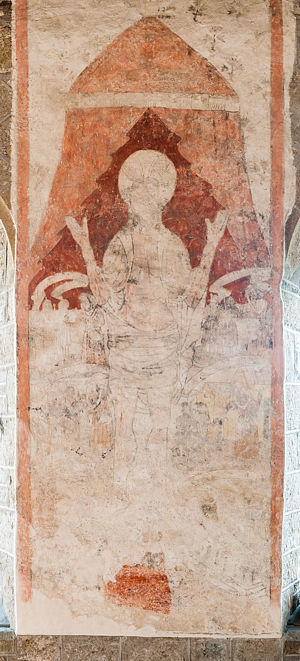
This is certainly the most accomplished painting now remaining in Cornwall, and even in the Middle Ages it must have been among the finest. The haloed Christ, wearing loose draperies and showing the wounds in his raised hands, stands before an unusual canopy broadly similar to the kind of bower or ceremonial tent in which medieval kings and princes might receive each other on the battlefield. Certainly the dark red triangular area immediately behind his figure seems to suggest this kind of structure, but it may be that this is simply a variation on the ‘cloth of honour’ sometimes found behind divine figures, as at Arundel.
Christ is surrounded by small scenes showing the Works, three on either side (including the Burial of the Dead, with the outline of a 15th century sarcophagus just visible in the main picture, at the lower right). The seventh scene, Tending the Sick, was below his feet, where a squarish area of red pigment is all that remains.
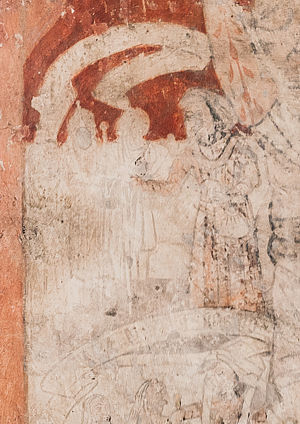
The scenes begin at the top left with Feeding the Hungry (detail, left). Two men holding staves, one in a longer robe and one in a shorter, stand at the left, while another man in a voluminous liripipe headress (an ambitious choice, with its convoluted wrapping) hands them something that looks like a loaf of bread, with a domed top. As in all the clearer scenes, this man has a sizeable bag attached to his waist.
Scrolls abound in this painting, all of them unfortunately unreadable now. One of the clearest is in the scene below this (detail, below left), Clothing the Naked, where what seems to be a supplementary and narrower scroll is looped round the neck of the almsgiver. This particular detail is found in all the scenes, and it may once have held words spoken by the giving figure.
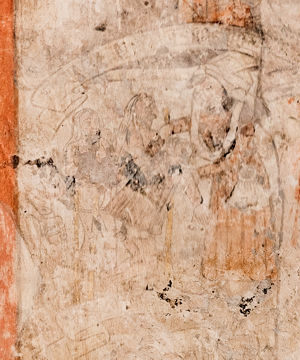
Clothing the Naked is very literally interpreted as usual, with the smock-like garment thrust emphatically over the head of a figure otherwise invisible except for an arm and hand. Two other men, both bearded and with long hair, stand to the left, the one furthest left apparently dressed in short drawers. This particular scene is perhaps the most accomplished of all of those now remaining, with obvious careful attention given to small details of physiognomy and posture. The almsgiver’s satchel, which may be ornamented with a scallop-shell, emblem of St James and the pilgrimage to Compostela, also shows very well.
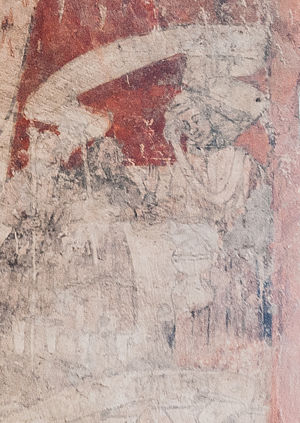
The clearest scene at the right is that at the top, corresponding to Feeding the Hungry at the top left. Giving Drink to the Thirsty (detail, right). Although the figures of giver and receivers are similarly organised within the space, the two men on the left do not appear to be the same two as those in Feeding the Hungry - and it is perhaps an indication of the painter’s skill and commitment that he should differentiate in this way. The almsgiver on the right holds an elaborate ewer in his left hand and a bowl, now very unclear, in his right.
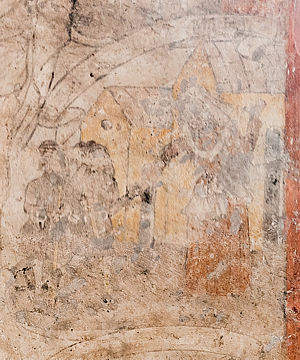
The remaining scenes are very faint, and only one is shown in detail here. Directly below Giving Drink to the Thirsty (i.e. at the middle right) is Receiving the Stranger (detail, below left), which features a large gabled house with a round window and a tiled roof painted in yellow ochre. Although other details are obscure now, according to old notes on the painting available in the church, one of the two ‘strangers’ standing beside the house is removing his hat preparatory to entering, and the almsgiving figure on the right ushers the two in.
The two remaining scenes have already been mentioned. Tending the Sick (the area of red pigment between Christ’s feet was originally a bedcover) and Burying the Dead at the lower right both once had two or three attendant figures around the bed and the classical-style sarcophagus respectively.
Some Cornish wall paintings have had to endure over-zealous ‘restoration’ in the past, and have been travestied as a result, but the Linkinhorne Seven Works of Mercy has, fortunately, been treated with the care and restraint that it deserves. There is another very obscure painting nearby on the wall, perhaps another morality or possibly a Doom, but it eludes certain identification now.
You can see a 360° panorama of the interior of the church here.
Website for St Melor’s church, Linkinhorne
Photos © Roy Reed 2019